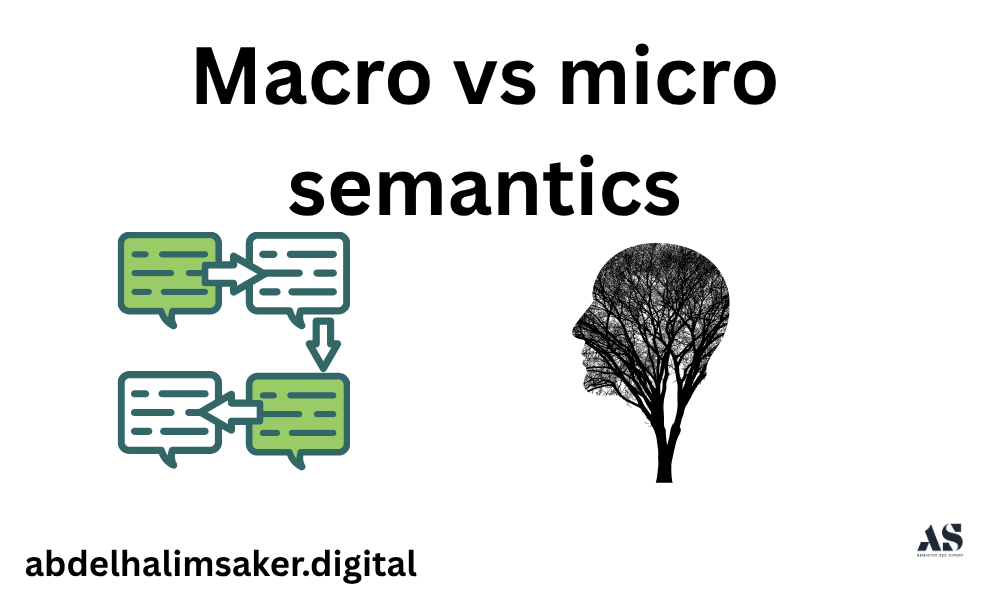
Macro and micro semantics represent two hierarchical levels of meaning in Semantic SEO.
- Macro semantics define the global topical context of a website or domain — how the overall entity is perceived in Google’s semantic graph.
- Micro semantics define the local meaning layer at the paragraph and sentence level — how individual words, predicates, and co-occurrences express relationships.
Both layers work together to shape how search engines interpret, index, and rank content based on entity relationships, semantic proximity, and contextual cohesion.
What Is Macro Semantics
Macro semantics refers to the sitewide or domain-level meaning network built through thematic consistency, entity structure, and linking patterns.
It defines what a website is about in the eyes of Google’s knowledge and link graphs.
Macro semantics = Global context + Domain entity connections.
For example:
- A site publishing content about Semantic SEO, NLP, and Google ranking models develops a macro-semantic field around search intelligence and information retrieval.
- Google uses this contextual field to classify the domain under a specific topical vector, influencing how easily new pages rank for related topics.
How Macro Semantics Are Formed (Sitewide Entities, Headings, Links)
Macro semantics emerge from the aggregate signals across your domain. These include entities, headings, URLs, schemas, and internal links.
1. Sitewide Entities
Entities consistently mentioned across multiple pages shape domain identity.
For example:
- A domain with recurring entities like Google, BERT, entity extraction, semantic relevance signals a strong macro association with search engine linguistics.
- These recurring entities anchor the macro meaning through repetition and co-reference.
2. Heading Architecture
Headings form the macro skeleton of your topical structure.
When Google crawls headings across pages, it builds a semantic map of your content’s breadth and depth.
Example heading hierarchy:
- H1: What Is Semantic SEO
- H2: How Google Understands Entities
- H2: What Is Query Semantics
- H2: How Semantic Distance Shapes Ranking
This consistent pattern teaches Google that your domain’s macro semantics revolve around SEO meaning modeling.
3. Internal Linking Patterns
Internal links define semantic relationships between clusters.
Links between semantically close pages create a macro network of meaning.
The anchor text used in these links helps distribute topical signals throughout the site.
Example:
- What Is Query Semantics → links to → How Search Engines Use Semantic Distance.
- How Google Understands Entities → links to → Difference Between Macro and Micro Semantics.
Every contextual link shortens the semantic distance between clusters, strengthening macro-level cohesion.
What Is Micro Semantics
Micro semantics operate at the local textual level — within paragraphs, sentences, and even word sequences.
They describe how linguistic elements (words, predicates, modifiers, entities) interact to create meaning at a granular scale.
In SEO, micro semantics determine how search engines interpret query relevance, intent satisfaction, and sentence-level meaning vectors.
Semantic triple:
For example:
“Google’s BERT model understands how entities relate through context and predicate direction.”
In this single sentence:
- Entity: Google, BERT model
- Predicate: understands
- Relationship: BERT model ↔ context comprehension
This micro-level meaning contributes to macro-level entity understanding across the page.
Word Order and Predicate Directio
Word order and predicate direction determine how meaning is encoded in a sentence.
Search engines interpret these directions using dependency parsing and semantic role labeling (SRL) models.
Example 1 — Predicate Direction Shift
- “BERT analyzes text meaning.”
- Subject → Predicate → Object
- (BERT) → (analyzes) → (text meaning)
- “Text meaning is analyzed by BERT.”
- Object → Predicate → Subject
- (Text meaning) → (is analyzed by) → (BERT)
While both sentences express the same concept to humans, their syntactic direction changes the semantic graph shape.
Google’s NLP models (BERT, MUM, T5) normalize both directions but prefer active predicates for clarity.
Optimization Rule
- Use active voice and explicit subjects.
- Maintain logical subject-predicate-object flow.
- Avoid ambiguous referents like “it,” “this,” or “they” without context.
This ensures micro semantics are clean and machine-interpretable.
Sentence-Level Semantic Weight
Every sentence carries semantic weight — the measure of its informational value relative to the main entity or topic.
Google evaluates this weight through co-occurrence strength, predicate relevance, and contextual density.
Factors Increasing Semantic Weight:
- Presence of main entities and related terms.
- Strong predicate alignment (verbs defining relationships).
- Compact factual expression (short, information-rich sentences).
Example:
- Weak: “BERT is interesting and works somehow.”
- Strong: “BERT processes sentence meaning by analyzing word dependencies and context vectors.”
The second sentence has higher semantic compression — more meaning per word — which improves NLP readability and semantic clarity.
Why Both Levels Matter Together
Macro and micro semantics are interdependent layers.
Macro semantics set the contextual field, while micro semantics populate that field with precise meaning signals.
Without macro semantics, content appears fragmented or topically inconsistent.
Without micro semantics, content appears shallow or semantically vague.
Conceptual relationship:
Macro = “What the domain is about.”
Micro = “How each sentence communicates meaning.”
Example:
Macro semantic goal: Build authority around Semantic SEO.
Micro semantic execution:
Use precise sentences describing entities, attributes, and relationships in the search engine language model context.
Each micro unit strengthens macro identity through repetition, co-reference, and entity linking.
Semantic Reinforcement Loop
When multiple microsemantic patterns repeat across pages, they reinforce macro-level meaning.
Google’s Neural Matching and Knowledge Graph systems detect these repetitions as consistent topical behavior.
Example:
Across 50 pages, you consistently use sentences like:
- “Semantic SEO improves contextual relevance.”
- “Search engines measure semantic distance to rank content.”
- “Entity-based optimization defines topical clarity.”
These micro patterns signal to Google that your domain expertise lies within semantic web optimization.
Thus, micro repetition aggregates into macro recognition.
How to Optimize Macro and Micro Semantics in Practice
Effective optimization involves managing both levels of meaning simultaneously.
Your site must have macro coherence (domain structure) and micro precision (linguistic clarity).
1. Structuring for Macro Semantics
Macro optimization starts with topical architecture — how your content and internal links form a semantic map.
Key Components
| Element | Role in Macro Semantics | Optimization Focus |
|---|---|---|
| URL taxonomy | Defines thematic zones | Use descriptive, entity-based slugs |
| Heading hierarchy | Reflects topic flow | Align H1–H3 to semantic relations |
| Internal linking | Builds conceptual edges | Link semantically close pages |
| Schema markup | Defines entity relations | Use Article, About, and mainEntity |
| Content clusters | Group related entities | Maintain short semantic distance |
Example macro structure for Semantic SEO domain:
- /semantic-seo/what-is-semantic-seo
- /semantic-seo/query-semantics
- /semantic-seo/semantic-distance
- /semantic-seo/macro-vs-micro-semantics
All pages share core entities (semantic, SEO, entity, meaning) and contextual linkages.
2. Writing for Micro Semantics
Micro optimization focuses on sentence-level structure and predicate clarity.
Guidelines:
- Begin sentences with the subject entity.
- Use strong verbs to define relationships.
- Avoid redundant modifiers.
- Keep sentence length under 20 words where possible.
- Ensure entity co-occurrence within paragraphs.
Example:
Bad: “It is a good thing that BERT helps understand text.”
Good: “BERT improves Google’s understanding of sentence meaning through contextual embeddings.”
The improved version has direct predicate action, entity linking, and semantic precision — microsemantic optimization at work.
3. Aligning Headings and Paragraphs
Each heading should introduce a semantically close subtopic to the main entity.
The first paragraph under each heading should directly answer the implicit query (IQQI principle).
Example structure:
- H2: What Is Macro Semantics?
→ Paragraph defines the macro concept immediately. - H3: How Macro Semantics Are Formed
→ Paragraph explains the formation process with entities and examples.
This creates predictable semantic flow, which helps Google identify hierarchical meaning layers.
4. Designing Anchor Texts
Anchor texts connect micro-level meaning with macro-level themes.
Each link’s anchor should reflect the semantic intent of its target page.
Example:
- Correct: “Learn how Google measures semantic distance.”
- Incorrect: “Click here to read more.”
Semantic anchor texts act as predicate bridges between concepts, allowing Google to map entity relationships more efficiently.
5. Using Schema for Reinforcement
Schema markup translates micro-level meaning into structured data — reinforcing macro context.
Example (simplified JSON-LD):
{
"@context": "https://schema.org",
"@type": "Article",
"headline": "Difference Between Macro and Micro Semantics",
"about": ["Semantic SEO", "Macro Semantics", "Micro Semantics"],
"mainEntity": {
"@type": "Thing",
"name": "Macro and Micro Semantics",
"sameAs": [
"https://developers.google.com/search/blog",
"https://en.wikipedia.org/wiki/Semantic_Web"
]
}
}
This structured declaration helps Google understand entity scope and relationship depth.
6. Avoiding Semantic Drift
Semantic drift occurs when content deviates from its core topical meaning.
It increases semantic distance between the page and the domain theme, weakening macro signals.
Prevention tactics:
- Keep entity co-occurrence within defined topical boundaries.
- Use LSI terms and synonyms that maintain conceptual proximity.
- Avoid mixing unrelated fields (e.g., inserting social media trends in a semantic SEO guide).
Example:
Stay within the same semantic radius —
Entity → Attribute → Process → Example — rather than branching into disconnected concepts.
7. Example: Combining Macro and Micro Semantics
Scenario:
You’re writing an article on “Entity Disambiguation.”
- Macro goal: Strengthen topical authority under the Semantic SEO cluster.
- Micro strategy:
- Start with precise entity definitions.
- Use predicates like identifies, distinguishes, links, resolves.
- Include related entities: Google, Knowledge Graph, context vectors.
Result:
Google interprets your page as micro-aligned (local clarity) and macro-reinforced (cluster cohesion).
This balance boosts ranking stability and entity association strength.
The Relationship Between Macro and Micro Semantics in Topical Authority
Topical authority depends on the synchronization between macro and micro meaning levels.
Mechanism:
- Micro semantics → supply data points (entities, facts, actions).
- Macro semantics → integrate those data points into a coherent context network.
Over time, this synchronization builds behavioral trust and semantic predictability in Google’s eyes.
The search engine learns that your domain consistently produces linguistically precise and contextually aligned content.
Key Takeaways for SEO Practitioners
| Aspect | Macro Semantics | Micro Semantics |
|---|---|---|
| Scope | Sitewide / Domain | Sentence / Paragraph |
| Focus | Topical cohesion | Linguistic precision |
| Signals | Internal links, headings, entities | Predicates, word order, co-occurrence |
| Optimization | Topical map design | Sentence structure, meaning density |
| Goal | Define what your site is about | Clarify how each sentence conveys meaning |
Both are inseparable layers in the same semantic hierarchy.
Neglecting one disrupts meaning integration and weakens your site’s contextual authority.
Example Visualization: Macro vs Micro Semantic Flow
| Level | Example | Semantic Effect |
|---|---|---|
| Macro (H1–H2) | “What Is Semantic SEO” | Defines domain-wide meaning field |
| Meso (H3–H4) | “How Google Understands Entities” | Expands topic hierarchy |
| Micro (Sentence) | “BERT extracts contextual meaning from entity co-occurrence.” | Builds local meaning precision |
This layered flow mirrors how Google’s NLP stack interprets content — from macro context recognition to micro meaning parsing.
Closing Synthesis
Macro semantics describe the site’s thematic identity, while micro semantics describe the meaning mechanisms that construct it.
Together, they enable search engines to map your domain into the knowledge graph with precision.
When optimized correctly:
- Macro semantics provide breadth of context.
- Micro semantics provide depth of meaning.
The result is a contextually dense, entity-aware, and machine-understandable content ecosystem.
